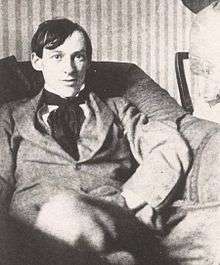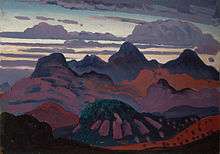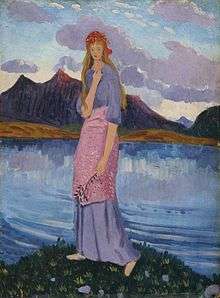James Dickson Innes


James Dickson Innes (27 February 1887 – 22 August 1914) was a British painter, mainly of mountain landscapes but occasionally of figure subjects. He worked in both oils and watercolours.
Style
Of his style, art historian David Fraser Jenkins wrote: "Like that of the fauves in France and the expressionists in Germany, the style of his work is primitive: it is child-like in technique and is associated with the landscape of remote places."[1]
Biography

James Dickson Innes was born on 27 February 1887 in Llanelli, in south Wales. His father, John Innes, who had come from Scotland, was an historian and had an interest in a local brass and copper works; his mother was of Catalan descent. He had two brothers, Alfred and Jack.
His parents sent him to be educated at Christ College, Brecon. Afterwards he studied at the Carmarthen School of Art (1904–05), from where he won a scholarship to the Slade School of Art in London (1905–08). His teachers at the Slade included P. Wilson Steer.[3]
From 1907 he exhibited with the New English Art Club; and in 1911 he became a member of the Camden Town Group.[4] The Camden Town Group included Walter Sickert who was an influence on Innes's art, and Augustus John with whom Innes became friends.[3]
In 1911 he had a two-man exhibition with Eric Gill at the Chenil Gallery, London: "Sculptures by Mr Eric Gill and Landscapes by Mr J. D. Innes".[1][5]
The Welsh politician and philanthropist Winifred Coombe Tennant (1874–1956) was an important patron of his work.[3]
In 1913 Innes exhibited in the influential Armory Show in New York City, Chicago and Boston.[3]
In 1911 and 1912 he spent some time painting with Augustus John around Arenig Fawr in the Arenig valley in North Wales; but much of his work was done overseas, mainly in France (1908–1913), notably at Collioure, but also in Spain (1913) and Morocco (1913) – foreign travel having been prescribed after he was diagnosed with tuberculosis. Eventually, on 22 August 1914, at the age of twenty-seven, he died of the disease at a nursing home in Swanley, Kent.
Legacy
Innes was unusual for a British artist of that time, because of his bold painting style, more attuned to the French post-impressionists. It has been argued his unusual style led the way for British artists such as David Hockney.[6]
In 2014 an exhibition of Innes' works was staged at the National Museum of Wales, Cardiff.[6]
Select works
- The Seine at Caudebec (1908)
- Thunder in the Mountains (1910)
- The Waterfall (1910) (Tate Gallery, London)
- Moorland Landscape with Sunset, Collioure (c. 1910) (Winnipeg Art Gallery)
- The Cathedral at Elne (1911) (National Museum Cardiff)
- Tryweryn Valley (1911) (Parc Howard Museum, Llanelli)
- Bala Lake (1911)
- Ranunculus (1912) (Walker Art Gallery, Liverpool)
- Arenig, North Wales (1913) (Tate Gallery, London)
- Inkwell and Pens (Museum of Modern Art Wales, Machynlleth)
Media
In 2011 Innes and Augustus John's fascination with painting Arenig Fawr and the Arenig valley was the subject of a BBC documentary titled The Mountain That Had to Be Painted.[7]
References
- 1 2 Fraser Jenkins, David (1975). J. D. Innes at the National Museum of Wales. National Museum of Wales. ISBN 0 7200 0055 6.
- ↑ https://www.museumwales.ac.uk/art/online/?action=show_item&item=838
- 1 2 3 4 Dutton, Peter (2014). "Dickie and Bryn – Llanelli Boys" (PDF). Friends of the Glynn Vivian Newsletter (Spring 2014): 3–4. Retrieved 5 November 2014.
- ↑ Baron, Wendy and Sickert, Walter. Sickert: Paintings and Drawings, p. 81, Yale University Press, 2006. ISBN 0-300-11129-0, ISBN 978-0-300-11129-3
- ↑ "Eric Gill – Crucifixion 1910". Tate.
- 1 2 Neil Prior (13 April 2014). "National Museum Cardiff stages James Dickson Innes exhibition". BBC News (Wales). Retrieved 16 July 2014.
- ↑ BBC Four, 18 May 2011, The Mountain that had to be Painted.
Further reading
- J. D. Innes 1887–1914 [exhibition catalogue Llanelli Public Library Nevill Memorial Gallery] (1987)
- Some Miraculous Promised Land: J. D. Innes, Augustus John and Derwent Lees in north Wales 1910–12 [exhibition catalogue, Mostyn Art Gallery, Llandudno] (1982)
- James Dickson Innes [exhibition catalogue, Southampton City Art Gallery, et alib.] (1978)
- Fraser Jenkins, David (1975). J. D. Innes at the National Museum of Wales. National Museum of Wales. ISBN 0 7200 0055 6.
- Modern English Painters Lewis to Moore by John Rothenstein (1956)
- Augustus John, Chiaroscuro (1952)
- J. Fothergill, James Dickson Innes (1948)
- R. Schwabe, 'Reminiscences of Fellow Students', in The Burlington Magazine (1943 January)
- Hoole, John; Simons, Margaret (2013). James Dickson Innes (1887–1914). Lund Humphries. ISBN 978-1848221390.
External links
| Wikimedia Commons has media related to James Dickson Innes. |
- National Museum of Wales, Art collections
- Paintings by James Dickson Innes at the Art UK site
- Tate – James Dickson Innes 1887–1914
- Blue Plaque for James Dickson Innes in Llanelli